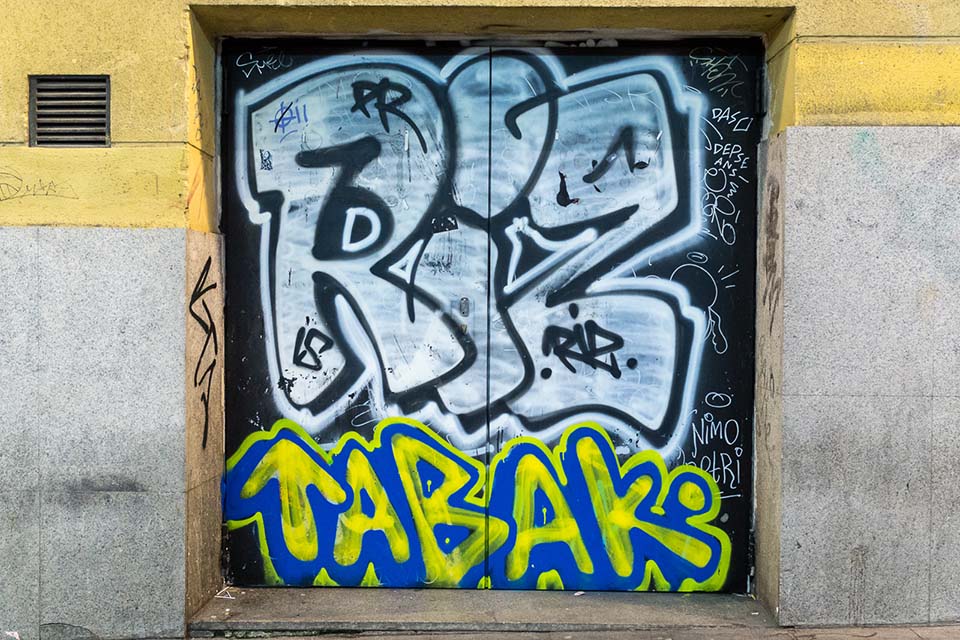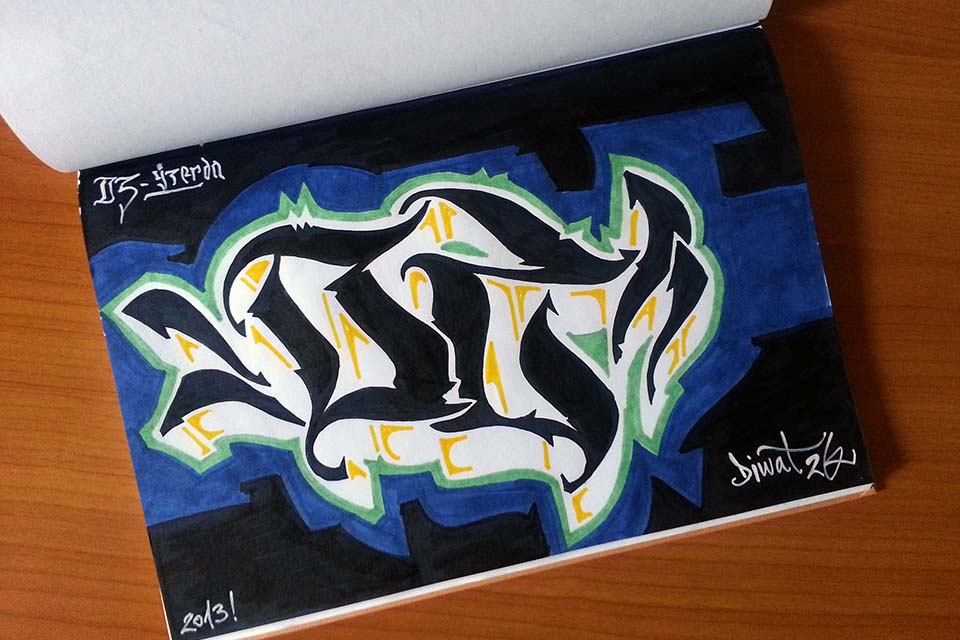Among Cooltourspain’s guided visits there is always one question that everyone wonders about. What’s the difference between graffiti and street art?
As a matter of fact, there is no absolute truth that could be applied to a single answer. Art expressions are complex, and they are linked to the city’s landscapes, underground subcultures or your own way of thinking.
We’ve gathered some of our guests’ answers during 3 years of experience, but they are not the only ones. Would you add any other one?
1-. The naming, first divergence between graffiti and street art.

Let’s start with the basics: the way we name artists. Could you recall one of the artists’ preferences within the graffiti community? Most of them call themselves “writers” instead of artists.
Tags (a simple signature) or throw-ups (bigger and more elaborated artworks) are two of the techniques that they use in order to paint their names.
Nicknames vs. real names

First difference we would find among artists is the way we call them.
Graffiti writers will never use their real name, whereas street art artists use their real name to be found either on Instagram or Google.
For instance, let’s talk about a former duo in Madrid, now working separately, called Defo and Ruka. They are quite popular!
Would you think that they were going to use the name which appears on their ID to sign their works if they are working illegally? It doesn’t make sense, right?
On the other hand, we could find graphic designers, illustrators, or just contemporary art artists who have recently joined the street art industry to sell their works:
- Marta Lapeña, muralist based in Madrid.
- Guillermo J Bueno, emerging artist from El Keller workshop.
- Asier Vera Maceiras, basque urban artist based in El Bierzo.
What other names could we use to refer to artists?

Artists who work with visual concepts wouldn’t call themselves writers if they were interested in making a career in the modern art industry.
Which terms do they frequently use to present their portfolio to gallerists and private collectors in art fairs?
- Street art artist,
- Urban artist,
- Contemporary artist,
- Post-graffiti artist
2-. The materials, to spray or not to spray.

Another aspect in which graffiti and street art may differ is the type of materials used. This factor depends completely on the artist as an individual.
It is true that writers who grew up in the hip hop/graffiti culture always use spray paint, but it is not the only element we may observe in the streets.
What is the most used material in the graffiti industry?

On one hand, graffiti’s most common material is spray paint. It is easy to carry, it’s affordable (price varies between 2.5-4€/can), and it dries quickly.
Writers don’t normally use just one colour. When painting, they use at least a couple of them to create beautiful decorations.
Other materials used by writers are markers and street dabbers. They especially paint with them when travelling to foreign countries, as carry-on baggage does not permit containers over 100 ml.
What other supplies do street art artists use to express their ideas?

On the other hand, street art artists use a wide variety of materials. For example, it is very usual to see them using regular home paint and brushes, but they ain’t the only ones.
- Paper, observed in wheat paste and paste-ups,
- Stencils, frequently created with scrap X-ray films,
- Vinyl or eggshell stickers,
- clay, used in sculptures,
- fabrics or any other short of wool/textiles
Recycled objects are often used to create artworks. Bordalo II is a Portuguese artist who uses plastic materials to give a second life to non-disposable items. Have you ever seen any of his masterpieces?
3-. The visuals, two branches out of the same tree.

The use of imagery, or the absence of it, it’s another element in which graffiti and street art might be contrasted.
Here we need to make a separation in the intents of each art creation.
Do any graffiti artists use images?

Yes, loads of them! There are some graffiti artists who do not only focus on letters, but find themselves superior than others by mixing images with letters.
Graffiti creators use avatars related to their childhood to add difficulty and respect to their artworks.
Imagine at this point a guy/girl who paints whole cars (decorations on train wagons). If there exists a huge risk for them while creating their three-to-six letters on the side of a metro car, would you say that they risk more times their existence by painting a cartoon?
Of course! Artists adding characters to their artworks, risk more times than those who only paint letters.
Modern & abstract artists.

We’ve had the opportunity to talk to some artists who agree with the fact that real images aren’t necessary at all.
In that sense, street art responds to a need of expression. An idea which has to be transmitted to the universe. Even if it’s just a daily event, or if it’s a game with the audience, most street art artists use abstraction to express feelings or philosophical points of view.
This is a list of Spanish modern abstract urban artists to follow on instagram:
- Jesús Moreno, aka YES: lines & color figures created with a geometric language.
- The ‘Ancentral Futurism’ created by Sixe Paredes, a tribute to the primitive cultures in the search for the essential.
4-. The differences between ‘graffiti and street art’ according to the law and order.
It is clear that controversy separates the graffiti and street art industries. This aspect may go unnoticed most of the time, but it’s the most defining one from our point view.
Painting with or without permission is what creates this big disagreement between in the artistic community.
Did you say “you are not allowed to paint here”?

Graffiti writers do not ask for permission most of the times. They create in public spaces, or in private properties, but never ask if they can do it or not.
Their golden rule is to never be caught. That’s why they paint at night, they go “on a mission” in pairs or groups, being careful of never using lights/ mobile phones/ lighters if they are painting in train tracks.
Did you know that big fishes in the art world also created thousands of illegal pieces? Just to mention some of them:
- Ben Eine,
- Banksy,
- Obey, aka Shepard Fairey
Permission granted to paint.

Artists who want to avoid fines that go from 300€ to 3,000€ usually submit their portfolios to different street art festivals and modern art events.
They take their time to elaborate the artworks, where the public audience enjoys their skills & professionalism.
These are some of the street art festivals around the country where artists leave their signature in a permitted way:
- Pinta Malasaña
- CALLE Lavapies
- Galería urbana Salamanca
Our opinion on graffiti and street art.
We are lucky enough to have friends on both sides. Some of the Cooltourspain team members do paint graffiti and street art in their free time.
We do search hidden places, underground tunnels, abandoned warehouses and locations where it’s very difficult that police catches you.
Let’s keep on colouring the world!


Leave a Reply